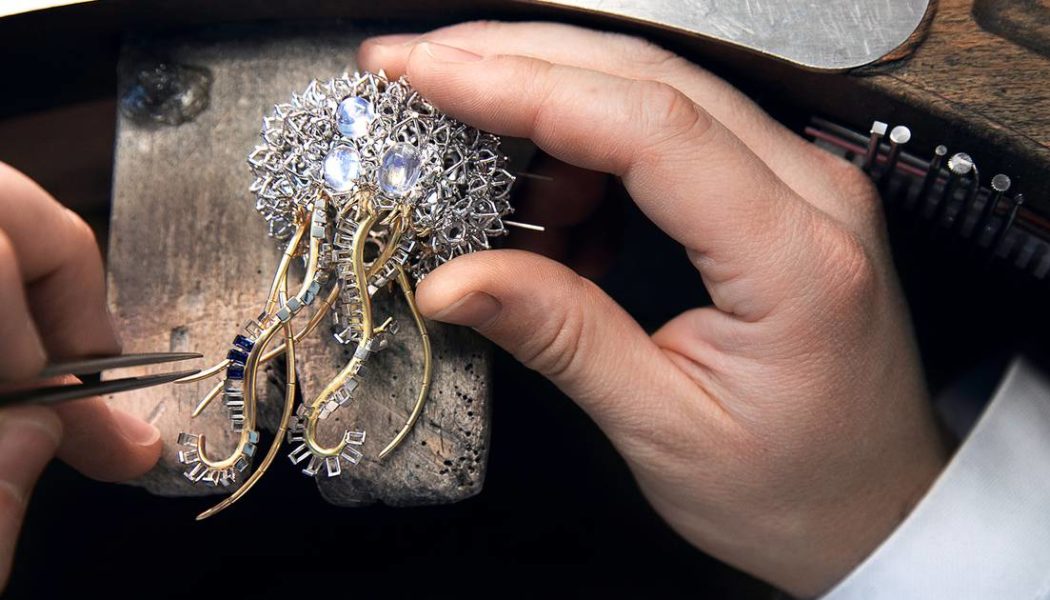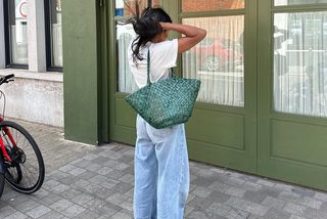
On a recent afternoon at Tiffany & Co.’s jewellery studio in Manhattan, a dozen or so jewellers filed down gold engagement rings while a tiny vacuum installed at each of their workstations sucked up the gold dust to melt it down and recycle it. It’s a slow, meticulous task, in many ways little different from the process artisans have followed for hundreds of years.
At each station, there’s a small wood block, with a V-shape carved out in the middle, that’s attached to the worktable just below eye level. It’s called a bench pin, and the jewellers place the rings there to file them down. The bench pins of the more experienced jewellers are so worn that they almost look like pieces of driftwood. But some have few grooves, a sign of the tenure of their owners: apprentices.
Two of the ringmakers at work in the jewellery studio this day are among the eight trainees in Tiffany’s two-year apprenticeship program. LVMH Moët Hennessy Louis Vuitton SE and Tiffany have teamed up with New York City’s Fashion Institute of Technology and Studio Jewelers, a trade school in Manhattan, to give the apprentices theoretical and technical training. They also get practical experience working alongside seasoned Tiffany jewellers. Earlier this year, Tiffany launched another program for seven more apprentices, who are taking classes at the Rhode Island School of Design. The jeweler pays the trainees’ salaries while they’re in the program, and if they master the skills, they’ll have the opportunity to remain at Tiffany and craft luxury jewellery.
“We are teaching the next generation of craftspeople how important the details are,” says Dana Naberezny, chief innovation officer of jewellery at Tiffany and head of its workshop in Manhattan, as she walks among the workbenches and shows off a hanging display of hammer-like tools, including one used by the grandfather of one of the jewellers.
Training the next generation of luxe artisans has become a critical mission for Tiffany’s parent, LVMH, the French conglomerate that also owns Louis Vuitton, Christian Dior and six dozen other brands. The world’s largest luxury company is facing a worker shortage that threatens to curb its production of sought-after handbags, shoes and jewellery, underscoring the broader industry’s challenge to balance strong demand for high-end, handmade goods with fading interest in craftsmanship as a career.
LVMH is forecasting that it will have a deficit of 22,000 workers by the end of 2025, a record shortfall. Around two-thirds of those positions must be filled by salespeople at LVMH’s upscale stores and employees at its hotels around the world. The remaining third are craftspeople and designers—a smaller figure, but one that in many ways is more crucial for the company to address. Much of the appeal of LVMH’s most coveted items—a Tiffany engagement ring, a Loewe leather purse, a Hublot watch or a Loro Piana sweater—is that they’re at least partially handmade. The craftsmanship is part of what underpins the items’ lofty prices and the company’s marketing pitch that it’s honouring the heritage of its brands, some founded more than a century ago.
Despite a recent slowdown in the pace of sales at LVMH and other luxury brands, demand for high-end goods is much more robust than it was before the pandemic. That’s colliding with a decades-long decline in the number of people who know how to solder and set high-end jewellery, seamlessly stitch handbags that cost more than most people’s monthly rent or assemble leather shoes from scratch. With each generation, more workers in the US and Europe have been turning away from this type of manual work, instead preferring positions tied to what’s known as the knowledge economy.
LVMH is trying to address its worker shortage by ramping up hands-on training, with the goal of launching the careers of thousands of artisans in the coming years. “People aren’t trained,” says Alexandre Boquel, who’s based in Paris and runs LVMH’s apprenticeship program, known as Métiers d’Excellence. “We need to find them and train them.”
The goal of the apprenticeships, says Boquel, is to “perpetuate the savoir-faire of the group.” If he and his colleagues aren’t successful at creating a pipeline of skilled workers for the conglomerate, then they won’t be able to “sustain the current levels of growth,” he adds.
The difficulty in hiring skilled craftspeople is already hindering the pace of growth at other luxury companies. “We’re looking desperately to hire people,” says Marco Angeloni, chief executive officer of suitmaker Raffaele Caruso SpA. “It’s been my No. 1 headache for the past year.”
Caruso is based in Parma, Italy, and turns out men’s suits that can retail for as much as $5,000 each for some of the world’s top luxury brands. The suits, which the company also sells wholesale, take employees about nine hours to create by hand. The pandemic exacerbated the worker shortage, Angeloni says, because many companies in Italy and elsewhere temporarily shut down or scaled back their production, sending many senior craftspeople into early retirement and forcing junior employees into other industries. Small factories, unable to survive, shut down completely.
During Covid-19, “formalwear seemed doomed—everyone thought the jacket was dead,” Angeloni says. Then demand surged as the pandemic receded. By then Caruso employed fewer workers, and Angeloni couldn’t outsource some of his production as he usually did, since so many small factories were gone or had been bought by major luxury brands eager to guarantee their own source of production. “When demand came back, people weren’t as excited to come back to work as we were expecting,” he says. “Many had changed their lifestyles or industry.”
Angeloni has added 45 more workers to Caruso’s staff of 450 since the beginning of the year—including two senior people he asked to come out of retirement to help train the newcomers—but it’s not enough. If the company had enough staff, Angeloni estimates, sales could have increased by 70% this year versus last. Instead, they will increase by 30%. “Opportunities have been lost,” he says, “for us and the brands.”
Nicolas Girotto, CEO of Swiss luxury shoe company Bally, says he constantly has about five to 10 vacancies for artisans. “The long-term trend for luxury overall is constant growth,” he says. Since hiring isn’t keeping pace, Girotto says he’s focusing on having each of his company’s artisans learn several steps in the shoemaking process instead of specialising in one—a break with tradition.
As many as 250 separate steps are required to craft Bally’s highest-end shoes. About 20% of the 100 or so artisans in Bally’s atelier in Lugano, Switzerland, have been trained in more than one task. “The more skills they have, the better for the company and the better for themselves,” Girotto says.
LVMH’s apprenticeship strategy—start piquing the interest of potential trainees as students, and expand the program to include more jobs and geographies over time—will be closely watched by other executives in the luxury industry. The French giant is training 700 apprentices this year, up from 180 in 2018, and it aims to have even more next year.
One-third of LVMH’s new apprentices are “reskilling,” meaning learning new skills that are loosely tied to their current profession, such as a product leader in marketing training to become a jeweller. Before the pandemic, that figure stood at around 10%. Boquel attributes the jump to a desire that arose in France and elsewhere during the pandemic to diminish the grip the digital world has on our lives. “A lot of people in France have been thinking that ‘I need to get back to something very tactile, to do something with my hands,’” he says. “It was surprising to see how many 40- to 45-year-olds were contacting us to find a profession as a jeweler.”
Part of Boquel’s work is getting the word out about the breadth of jobs available at LVMH and its 75 brands. He organises workshops at high schools in France and the US, for example, to introduce young people to the opportunities.
“People don’t know 1% of these professions,” Boquel says. LVMH has 280 careers, he says, including calligraphers for Hennessy’s cognac barrels and artisans at Berluti who sculpt shoe moulds known as lasts from a block of hornbeam wood using a knife-like tool called a paroir. These artisans then file and smooth down the mould with a rasp, followed by sandpaper—a process that, according to Berluti’s website, emphasises “the elegant line of the shoe.” A pair of the brand’s Oxfords retails for around $2,500.
Most of LVMH’s current crop of trainees are based in France, Italy and Switzerland, and the company is expanding into other countries, including the US, where it plans to initiate more apprenticeships in addition to the two Tiffany programs. While apprenticeships are a traditional—and still common—way to train workers in countries such as France, Germany and Switzerland, they’re far less prevalent in the US, says Robert Lerman, who’s researched apprenticeships for three decades as a fellow at the Urban Institute, a Washington-based think tank. France under President Emmanuel Macron spends billions each year to successfully expand apprenticeships, yet the US only invests about $300 million annually, Lerman says.
Most apprenticeships in the US focus on training construction workers, electricians and plumbers. If LVMH’s rollout is successful, “it would be a great example to other firms in that industry,” he says. “It’s learning by doing. You can’t create jewellery just from a classroom.”
In France, it’s relatively straightforward to begin an apprenticeship program compared with the US. The cost to train apprentices is financed by an apprenticeship tax on companies, and trainees’ wages are paid by their employer. And there’s a plethora of schools tied to the fashion industry, which makes it easier for LVMH to set up training programs and contact potential apprentices. In the US, though, “we had to build something completely from scratch, inspired by France’s concept,” Boquel says.
By Jeannette Neumann
Learn more:
How the LVMH & Tiffany Deal Will Reshape Luxury
The agreement, which knocks a modest $400 million off the original $16.2 billion price tag, ends weeks of corporate fighting and puts the French group in a position to be a dominant force in jewellery.









